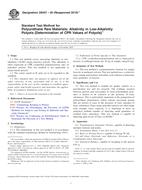We need your consent to use the individual data so that you can see information about your interests, among other things. Click "OK" to give your consent.
ASTM D6437-05(2010)e1
Standard Test Method for Polyurethane Raw Materials: alkalinity in Low-Alkalinity Polyols (Determination of CPR values of Polyols) (Includes all amendments And changes 4/8/2016).
Automatically translated name:
Standard Test Method for Polyurethane Raw Materials: alkalinity in Low-Alkalinity Polyols (Determination of CPR values of Polyols)
STANDARD published on 1.11.2010
The information about the standard:
Designation standards: ASTM D6437-05(2010)e1
Note: WITHDRAWN
Publication date standards: 1.11.2010
SKU: NS-35137
The number of pages: 3
Approximate weight : 9 g (0.02 lbs)
Country: American technical standard
Category: Technical standards ASTM
The category - similar standards:
Annotation of standard text ASTM D6437-05(2010)e1 :
Keywords:
alkalinity, basicity, CPR, polyether polyol, polyol, polyurethane, prepolymer, raw materials, test method, titration, urethane, Acidity, alkalinity, pH--plastics, CPR (controlled polymerization rate), Polyether polyols, Polyols, Polyurethane raw materials--polyols, Prepolymers, Titration, ICS Number Code 83.040.01 (Raw materials for rubber and plastics in general)
Additional information
| Significance and Use | ||||||
|
This test method is suitable for quality control, as a specification test and for research. The urethane reaction between polyols and isocyanates to form polyurethane polymers is known to be sensitive to the presence of basic substances. This is particularly important in the preparation of polyurethane prepolymers which contain isocyanate groups that are known to react in the presence of trace amounts of basic substances. Since many polyether polyols are often made with strongly basic catalysts, it is important to have an analytical method capable of detecting small quantities of residual basic substances. This test method is capable of detecting ppm levels of base (as KOH). |
||||||
| 1. Scope | ||||||
|
1.1 This test method covers measuring alkalinity in low-alkalinity (<0.002 meq/g basicity) polyols. This alkalinity is often expressed as CPR (controlled polymerization rate) of polyether polyols. This test method is not applicable to amine-based polyols. 1.2 The values stated in SI units are to be regarded as the standard. 1.3 This standard does not purport to address all of the safety concerns, if any, associated with its use. It is the responsibility of the user of this standard to establish appropriate safety and health practices and determine the applicability of regulatory limitations prior to use. Note 1—There is no known ISO equivalent to this standard. |
||||||
| 2. Referenced Documents | ||||||
|
We recommend:
Updating of laws
Do you want to be sure about the validity of used regulations?
We offer you a solution so that you could use valid and updated legislative regulations.
Would you like to get more information? Look at this page.




 Cookies
Cookies
